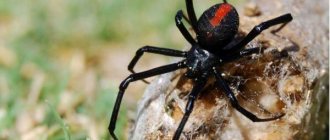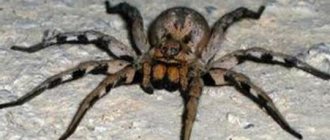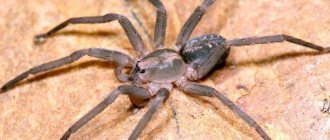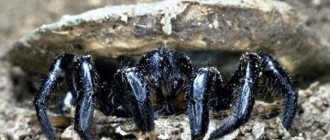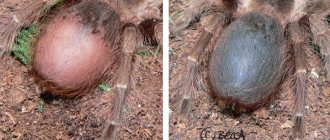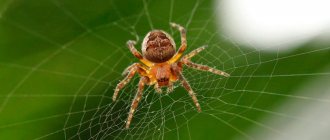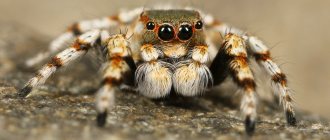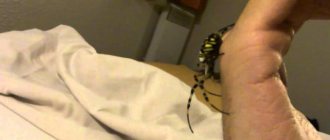- Wild animals
- >>
- Arachnids
The six-eyed sand spider is a medium-sized spider of deserts and other sandy environments in southern Africa. It is a member of the araneomorpha spider family, and close relatives of this spider are sometimes found in both Africa and South America. Its closest relatives are the recluse spiders, which are found throughout the world.
Origin of the species and description
Photo: Six-eyed sand spider
The six-eyed sand spider is also known as the six-eyed crab spider due to its flattened stance and laterid legs. It is believed that the venom from the bite of these spiders is the most dangerous among all spiders. The six-eyed sand spider is a living fossil that predates the Gondwanaland drift some 100 million years ago and is also found in South America. There are 6 species distributed in the Western Cape, Namibia and Northern Province.
They meet:
- in sand;
- on sand dunes;
- under rocks and rocky ledges;
- in close proximity to ant pits.
Video: Six-eyed sand spider
The six-eyed sand spider, native to the Northern Cape and Namibia, may be the deadliest spider in the world. Fortunately, due to its habitat, it is rare and does not seem to want to bite. However, this spider should not be handled as there is no effective treatment against its venom.
Fun Fact: The scientific name for the six-eyed sand spider family is Sicarius, which means "killer" and "sica" means curved dagger.
The genus to which the six-eyed sand spider belongs was first created in 1878 by Friedrich Karsch as Hexomma, with a single species, Hexomma hahni. However, by 1879, Karsh realized that the name had already been used in 1877 for a janitor species, so he published a replacement name, Hexophthalma.
In 1893, Eugene Simon transferred Hexophthalma hahni to the genus Sicarius, and Hexophthalma fell into disuse until a phylogenetic study in 2021 showed that African species of Sicarius, including the six-eyed sand spider, were distinct from each other, and revived the genus Hexophthalma for them. Two new species were added to the genus in 2021, and one previously accepted species, Hexophthalma testacea, is synonymized with the six-eyed sand spider. The number of species is expected to increase with further research.
Brown Widow
The brown widow is a shy creature and tries to avoid conflicts, but if provoked, a bite is almost guaranteed. The poison is very strong, but she injects only part of it, and therefore the bite does not pose much danger. Usually a person feels a slight pain, and within 24 hours toxins are eliminated from the body.
This species is a “relative” of the well-known black widow; it can be recognized by the yellow or orange hourglass pattern on its abdomen and the black stripes on its legs.
Distributed in South America and the southern USA, Asia, Australia and southern Africa. Females are much larger than males and much more dangerous.
Appearance and features
Photo: What a six-eyed sand spider looks like
The six-eyed sand spider has 6 eyes arranged in 3 dyads that are widely spaced in a curved row. The cuticle is leathery with curved bristles and is usually burgundy or yellow in color. The six-eyed sand spider is covered in small hairs called setae (a coarse hair, seta, bristle-like appendage, or part of an organism) that serve to hold sand particles. This provides effective camouflage even when the spider is not buried.
The six-eyed sand spider has a body length of up to 15 millimeters, and the width of the legs is about 50 millimeters. Most species are reddish-brown or yellow in color without any distinct patterns. Six-eyed sand spiders often camouflage themselves with particles of sand sandwiched between their body hairs to blend into the background of their specific habitat. Six-eyed sand spiders are shy and secretive, but will bite if accidentally contacted.
Fun fact: Six-eyed sand spiders can live up to 15 years, four times longer than the average spider.
These free-living spiders are terrestrial animals and have a uniform yellowish-brown overall color. Six-eyed sand spiders have a dusty, sandy appearance and take on the coloration of the ground they live on.
Benefit or harm?
It is impossible to remember cases in which a six-eyed sand spider has benefited humans or
animal world. Apparently, only harm comes from him, since meeting him can only mean one outcome - fatal. And everything will depend only on the time required to kill the victim.
For nature and insects, this arachnid species can be called an instrument of natural selection, which eats weak, sickly and careless insects.
Where does the six-eyed sand spider live?
Photo: Six-eyed sand spider in Africa
Based on evolutionary evidence, relatives of six-eyed sand spiders are thought to have originated in western Gondwana, which is one of two supercontinents that existed about 500 million years ago. Because they colonized this land so long ago, these spiders are sometimes called "living fossils." The current distribution of this spider family is mainly found in Africa and Latin America. This divergence is thought to have occurred when the supercontinents diverged approximately 100 million years ago, separating Africa from the Americas.
The six-eyed sand spider can be found in sandy areas of South and Central America. This spider lives in the desert and hunts in ambush. Unlike most hunters who wait for prey in ambush, the six-eyed sand spider does not dig a hole. Instead, it lurks just below the surface of the sand. It has a poison that is potentially fatal and can damage the heart, kidneys, liver and arteries, and cause flesh to rot.
These spiders do not make webs, but instead lie half-buried in the sand, waiting for prey to pass by. They are widespread, but are more common in dry areas. The six-eyed sand spider has a poor sense of direction, unlike other spider species.
Now you know where the six-eyed sand spider is found. Let's see what he eats.
Sandy six-eyed
Representatives of these arthropods continue to make the top 10 most dangerous spiders in the world. These are small individuals, reaching a length of 8-15 mm. Outwardly, such spiders resemble crabs. This resemblance is given to them by the relatively large legs bent at the knees, the length of which reaches 50 mm. The slightly flattened shape of the arthropod’s body also resembles a crab. This most dangerous spider (photo below) received its name because of its inherent shade of brown color and the presence of six eyes.
The habitats of the sand six-eyed are the territories of South Africa and the lands of South America. Depending on the area where they live, these spiders have different concentrations of the deadly substance in their saliva. Thus, African individuals are endowed with more lightning-fast and deadly poison than their American relatives. Perhaps the reason for this lies in the climatic characteristics of the Namib Desert.
The six-eyed sand spider hunts for small insects. Larger scorpions also become its victims. The spider waits for its prey, buried in the sand. The hairs located on the body help it in camouflage. Grains of sand stick to them, making the hunter a successful conspirator.
The venom of this spider affects the body of its victim in an unusual and unique way. A toxin still unknown to science negatively affects blood vessels, destroying their walls. This process occurs due to slow necrosis. The victim's blood also has a detrimental effect. It begins the active destruction of red blood cells. Thus, the venom of this arthropod is a very effective killing weapon. Fortunately, encounters between the six-eyed sand spider and humans are very rare. Only two cases of death resulting from an attack by this arthropod have been recorded.
What does the six-eyed sand spider eat?
Photo: Six-eyed sand spider in nature
The six-eyed sand spider does not wander around looking for prey, it simply waits for an insect or scorpion to pass by. When it does this, it grabs the prey with its front legs, kills it with poison, and eats it. Six-eyed sand spiders do not need feeding very often, and adult spiders can live for a very long time without food or water.
The six-eyed sand spider catches prey by hiding under the sand. It lifts its body, digs a hole, falls into it, and then covers itself with sand using its front paws. It catches prey with its front paws when the victim runs across the hidden spider. If a six-eyed sand spider is discovered, it will become covered in fine sand particles that adhere to the cuticle, acting as effective camouflage.
This spider's main food items are insects and scorpions, and they can wait up to a year to eat their prey because once they bite their prey, it is instantly immobilized. They feed on passing insects, quickly emerging from the sand when disturbed. During self-absorption, soil particles can stick to the specialized hairs that cover the spiders' bodies, changing their natural coloration to that of the environment.
While some predators have to deal with the problem of finding and capturing their prey, this spider allows the prey to come to it. Living modestly and sedentary, the spider camouflages itself by burying itself and sticking to sand particles and will wait until any prey gets too close. Once prey is in sight, the spider emerges from the sand and bites the prey, immediately injecting it with deadly venom. The insect is immediately immobilized and death occurs within a few seconds.
The necrotic effects of the six-eyed sand spider venom are caused by a family of proteins related to sphingomyelinase D, present in the venom of all spiders of this genus. In this respect, the genus resembles hermits. However, most species have been poorly studied, and the detailed effects of their venom in humans and other vertebrates are unknown.
Sydney leucopaweb or funnel web spider
The Sydney leukoweb or funnel web spider (lat. Atrax robustus) is a spider from the family Hexathelidae, the only one of the genus Atrax. Representative of the Australian continent. The funnel web spider is one of the few species of spiders that can cause serious harm to human health, and sometimes even kill him.
One bite from this spider is enough to kill a child. Death usually occurs within 15 minutes. The poison contains toxins that primarily affect the human nervous system. It is interesting that the venom of this spider is dangerous only for humans and primates, while it has no effect on other mammals.
Features of character and lifestyle
Photo: Six-eyed sand spiders
Fortunately, this spider, like the recluse spider, is very shy. However, research has shown that this spider venom is the most poisonous of all spiders. There is some question regarding the danger this spider poses. Although it is very shy and unlikely to bite humans, there are few (if any) recorded human envenomations by this species.
However, research has shown that the venom is particularly potent, with a potent hemolytic effect (rupture of red blood cells and release of hemoglobin into the surrounding fluid) and a necrotic effect (random death of cells and living tissue) causing blood to leak from vessels and tissue destruction.
The bite of the six-eyed sand spider causes many problems, including:
- leaking blood vessels;
- blood thinning;
- tissue damage.
Unlike the dangerous neurotoxic spiders, there is currently no antivenom for this spider's bite, leading many to suspect that this spider's bite can be fatal. There were no confirmed human bites and only two suspected cases. However, in one of these cases, the victim lost an arm due to massive necrosis, and in another, the victim died from severe bleeding similar to the effects of a rattlesnake bite.
Fun fact: The six-eyed sand spider rarely comes into contact with humans, and even when it does, it usually never bites. Additionally, like most spiders, it does not always inject venom with every bite, and even then it does not necessarily inject large amounts.
In summary, the docile behavior and natural history of six-eyed sand spiders have resulted in very few recorded bites, so the symptoms of their bites in humans are poorly understood.
Redback Spider (Australian Widow Spider)
Releases a deadly nerve agent. As a result of the bite, you can die from suffocation. Thanks to this poison, it is considered the most dangerous in Australia. It is found everywhere on this continent, including in cities.
He likes to hide in dry, warm places, so you can stumble upon him, for example, in an outdoor toilet or wearing old clothes in which he is hiding.
This spider can be recognized by the red stripe on its back. The bite is very painful, severe pain spreads throughout the body. Since the invention of the antidote in the 50s of the last century, no deaths have been recorded.
Social structure and reproduction
Photo: Six-eyed sand spider
Six-eyed sand spiders reproduce by laying eggs in silken bundles called egg sacs. Spiders often use complex mating rituals (especially in the visually advanced jumping spiders) to allow the male to get close enough to inseminate the female without causing a predatory response. Assuming mating initiation signals are exchanged correctly, the male spider must make a timely departure after mating to escape before the female eats him.
Like all spiders, the six-eyed sand spider is capable of producing silk from its abdominal glands. This is commonly used to create webs, such as spiders, which can be seen every day. The six-eyed sand spider does not make webs, however, it does use this unique ability to make silken bundles called egg sacs to surround its eggs.
Interesting fact: The egg sac is made up of many sand particles that are glued together using silk produced by a spider. Each of these egg sacs can hold many young eggs.
These spiders spend a surprisingly large portion of their lives in close association with sand, so it makes sense that they would end up in a world largely submerged in it. Because these spiders hide under the sand for most of their days, when the male approaches a female to mate, he does so slowly so as not to provoke a fight or flight response from the female spider.
10. Wolf Spider
Tenth place goes to the wolf spider. If you don't tease him, he doesn't bother you. In case of a bite, a burning sensation and slight pain may occur, but it does not pose a danger to humans.
The wolf spider family is divided into more than a hundred genera and has almost 2.5 thousand species. They live all over the world, except Antarctica, although they prefer warm climates.
These spiders do not weave webs, but ambush their prey. For this and for their habit of hunting alone, they got their name. Their sizes are 10-35 mm. It is interesting that females bear offspring on their own - they carry a cocoon with spiderlings with them.
Natural enemies of six-eyed sand spiders
Photo: What a six-eyed sand spider looks like
Six-eyed sand spiders have no natural predators. They themselves are the enemy of those who try to approach them. All members of the genus to which it belongs are capable of producing sphingomyelinase D or related proteins. It is a potent tissue-destroying substance unique to the spider family, otherwise found only in a few pathogenic bacteria.
The venom of many species of Sicariidae is highly necrotic in fact, capable of causing lesions (open wounds). Wounds take a long time to heal and may require skin grafts. If these open wounds become infected, serious consequences can occur. Rarely, the poison is carried by the bloodstream to the internal organs, causing systemic effects. Like their close relatives, the recluse spiders, the venom of the six-eyed sand spider is a powerful cytotoxin. This venom is both hemolytic and necrotic, meaning it causes leakage of blood vessels and destruction of flesh.
Most people bitten by a six-eyed sand spider simply wandered too close to its hiding place. There are ways to try to reduce the spider's damage, but there is no specific antivenom available. To avoid damage, it is best to avoid this spider completely, which should not be that difficult for most people when considering its habitat.
Brazilian wandering spider
In 2010, the Brazilian spider was listed in the Guinness Book of Records as the most dangerous on the planet. Its venom has a neurotoxic effect on the body, the bite is incredibly painful and leads to failure of the muscles, lungs and heart, death occurs from suffocation.
This is one of the largest spiders - up to 15 cm. It lives in the South American tropics and is also called banana for its habit of hiding in banana leaves.
During the day it hides in cracks and other inconspicuous places, and at night it “wanders” in search of prey. Sensing danger, he takes a stance and begins to attack, while never retreating. He likes to climb into houses, bags, clothes, and often people become victims of his bites through negligence.
